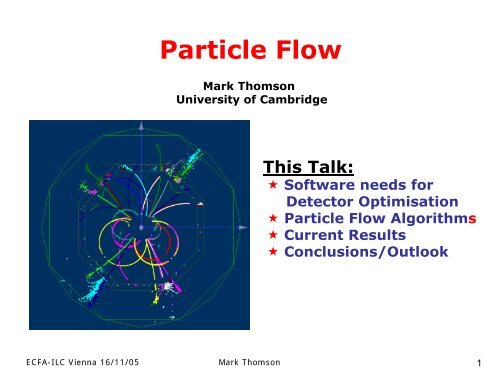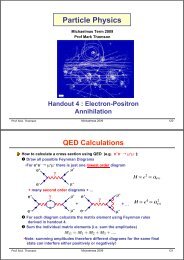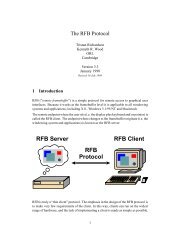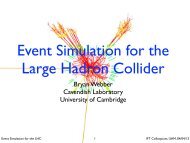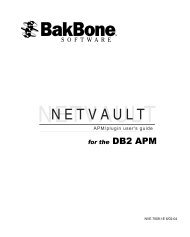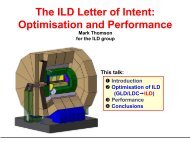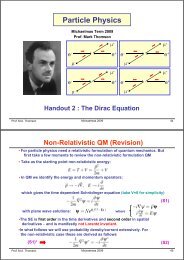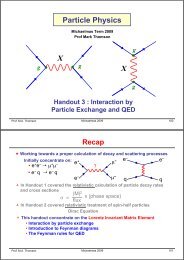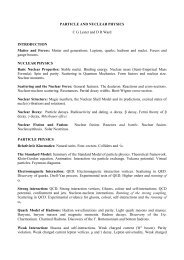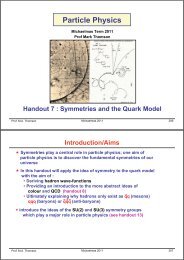Mark Thomson - High Energy Physics Group - University of Cambridge
Mark Thomson - High Energy Physics Group - University of Cambridge
Mark Thomson - High Energy Physics Group - University of Cambridge
Create successful ePaper yourself
Turn your PDF publications into a flip-book with our unique Google optimized e-Paper software.
Particle Flow<br />
<strong>Mark</strong> <strong>Thomson</strong><br />
<strong>University</strong> <strong>of</strong> <strong>Cambridge</strong><br />
This Talk:<br />
S<strong>of</strong>tware needs for<br />
Detector Optimisation<br />
Particle Flow Algorithms<br />
Current Results<br />
Conclusions/Outlook<br />
ECFA-ILC Vienna 16/11/05 <strong>Mark</strong> <strong>Thomson</strong> 1
Detector Optimisation<br />
General consensus that Calorimetry and PFA<br />
drives overall ILC detector design<br />
BUT: Don’t really know what makes a good detector from point <strong>of</strong><br />
view <strong>of</strong> PFA (plenty <strong>of</strong> personal biases – but little hard evidence)<br />
How to optimise compare ILC detector design(s)<br />
Optimize detector design using key physics processes<br />
Need to choose the key “benchmark” processes (DONE)<br />
e.g. the usual suspects + …..<br />
The rest is VERY DIFFICULT !<br />
Need unbiased comparison<br />
• Same/very similar reconstruction algorithms<br />
- these need to realistic (i.e. start-<strong>of</strong>-art)<br />
• Need Multiple PFAs : avoid trap <strong>of</strong> optimising detector to<br />
flaws <strong>of</strong> particular algorithm<br />
• This is a lot <strong>of</strong> work – need user friendly s<strong>of</strong>tware<br />
ECFA-ILC Vienna 16/11/05 <strong>Mark</strong> <strong>Thomson</strong> 2
Detector Optimisation : S<strong>of</strong>tware Tools<br />
Until very recently we did not have the s<strong>of</strong>tware tools to optimise the<br />
detector from the point <strong>of</strong> view <strong>of</strong> Particle Flow<br />
This has changed !<br />
The basic tools are mostly there:<br />
Mokka : now has scalable geometry for the LDC detector<br />
MARLIN: provides a nice (and simple) reconstruction framework<br />
LCIO: provides a common format for worldwide PFA studies<br />
Reconstruction: in MARLIN framework already have ALGORITHMs<br />
What is needed in MARLIN:<br />
Digitisation: (take simulated hits • hits)<br />
simple MARLIN processors exist (more work needed)<br />
Tracking: (two options currently in MARLIN)<br />
Full LEP like fit: TPC hits + currently being extended to VTX..<br />
“Cheated” tracks: TPC/FTD/VTX use MC to assign hits to<br />
track. Track parameters from a Helix fit<br />
Clustering: (two options)<br />
TrackWiseClustering (Alexei R. et al)<br />
MAGIC (Chris Ainsley)<br />
PFA: now (nearly) have two algorithms !<br />
Wolf (Alexei R.)<br />
PandoraPFA (<strong>Mark</strong> <strong>Thomson</strong>) – will be released in January<br />
ECFA-ILC Vienna 16/11/05 <strong>Mark</strong> <strong>Thomson</strong> 3
All the necessary tools exist !<br />
• that doesn’t mean that its time to stop work…<br />
• things aren’t perfect yet<br />
We are now in the position to start to learn how to<br />
optimise the detector for PFA<br />
But first…<br />
learning from ongoing studies <strong>of</strong> Perfect Particle Flow (P. Krstonosic)<br />
e.g. e + e - •Z •qq at 91.2 GeV<br />
To be<br />
reviewed<br />
σ [GeV]<br />
separate<br />
σ [GeV]<br />
not joined<br />
σ [GeV]<br />
σ %<br />
to total<br />
Effect<br />
total (% / E )<br />
E<br />
v<br />
> 0 0.84 0.84 0.84 (8.80%) 12.28<br />
<<br />
o<br />
0.73 1.11 1.11(11.65%) 9.28<br />
P<br />
t<br />
< 0.36 1.36 1.76 1.76(18.40%) 32.20<br />
σ<br />
HCAL 1.40 1.40 2.25(23.53%) 34.12<br />
σ<br />
ECAL 0.57 1.51 2.32(24.27%) 5.66<br />
M<br />
neutral 0.53 1.60 2.38(24.90%) 4.89<br />
M 0.30 1.63 2.40(25.10%) 1.57<br />
Cone 5<br />
charged<br />
(assumed sub-detector resolutions: ECAL 11%/√E, HCAL 50%/√E +4%)<br />
ECFA-ILC Vienna 16/11/05 <strong>Mark</strong> <strong>Thomson</strong> 4
Particle Flow Algorithms in MARLIN<br />
Snowmass<br />
Vienna<br />
Hits<br />
Sim. Hits<br />
Digitisation<br />
Hits<br />
LEPTracking<br />
TrackCheater<br />
TrackWiseClustering<br />
PFOs<br />
Tracks<br />
Clusters<br />
WOLF<br />
MAGIC<br />
PFOs<br />
Tracks<br />
PandoraPFA<br />
Clusters + PFOs<br />
PandoraPFA/WOLF/MAGIC share many common features<br />
Will briefly discuss some <strong>of</strong> the main points <strong>of</strong> the new Algorithm<br />
ECFA-ILC Vienna 16/11/05 <strong>Mark</strong> <strong>Thomson</strong> 5
PandoraPFA Clustering I<br />
All current MARLIN clustering algorithms are “forward projecting”<br />
• Form clusters starting from inner CAL layer – working outwards<br />
Arrange hits into PSEUDOLAYERS (same done in MAGIC)<br />
• i.e. order hits in increasing depth within calorimeter<br />
• PseudoLayers follow detector geometry<br />
• Hit in early layer<br />
• But high PseudoLayer<br />
(WOLF orders hits by distance from IP)<br />
ECFA-ILC Vienna 16/11/05 <strong>Mark</strong> <strong>Thomson</strong> 6
PandoraPFA Clustering II<br />
Start at inner layers and work outward<br />
Associate Hits with existing Clusters<br />
If multiple clusters “want” hit then Arbitrate<br />
Step back N layers until associated<br />
Then try to associate with hits in current layer (M pixel cut)<br />
If no association made form new Cluster<br />
+ tracks used to seed clusters<br />
0 1 2 3 4 5 6<br />
Simple cone algorithm<br />
based on current direction<br />
+ additional N pixels<br />
Cones based on either:<br />
initial PC direction or<br />
current PC direction<br />
Initial cluster<br />
direction<br />
Unmatched hits seeds<br />
new cluster<br />
WOLF/MAGIC do things<br />
slightly differently but<br />
same basic idea<br />
ECFA-ILC Vienna 16/11/05 <strong>Mark</strong> <strong>Thomson</strong> 7
PandoraPFA Cluster Association<br />
By design clustering errs on side <strong>of</strong> caution<br />
i.e. clusters tend to be split<br />
Philosophy: easier to put things together than split them up<br />
Clusters are then associated together in two stages:<br />
• 1) Tight cluster association - clear topologies<br />
• 2) Loose cluster association – catches what’s been<br />
missed but rather crude<br />
Photon ID<br />
Photon ID plays important role<br />
Simple “cut-based” photon ID applied to all clusters<br />
Clusters tagged as photons are immune from association<br />
procedure – just left alone<br />
Won’t merge<br />
Won’t merge<br />
Could get merged<br />
γ<br />
γ<br />
γ<br />
WOLF/MAGIC do things differently but both perform cluster merging<br />
ECFA-ILC Vienna 16/11/05 <strong>Mark</strong> <strong>Thomson</strong> 8
Cluster Association I : track merging<br />
LOOPERS<br />
Tight cut on extrapolation <strong>of</strong><br />
distance <strong>of</strong> closest approach<br />
<strong>of</strong> fits to ends <strong>of</strong> tracks<br />
SPLIT TRACKS<br />
gap<br />
Tight cut on extrapolation <strong>of</strong><br />
distance <strong>of</strong> closest approach<br />
<strong>of</strong> fits to end <strong>of</strong> inner tracks<br />
and start <strong>of</strong> outer track<br />
ECFA-ILC Vienna 16/11/05 <strong>Mark</strong> <strong>Thomson</strong> 9
Cluster Association II : Backscatters<br />
Forward propagation clustering algorithm has a major drawback:<br />
back scattered particles form separate clusters<br />
Project track-like clusters forward<br />
and check distance to shower centroids<br />
in subsequent N layers<br />
Also look for track-like segments at start<br />
<strong>of</strong> cluster and try to match to end <strong>of</strong><br />
another cluster<br />
ECFA-ILC Vienna 16/11/05 <strong>Mark</strong> <strong>Thomson</strong> 10
Cluster association III : MIP segments<br />
Look at clusters which are consistent with having tracks segments<br />
and project backwards/forward<br />
Apply tight matching criteria on basis <strong>of</strong> projected track<br />
[NB: + track quality i.e. chi2]<br />
ECFA-ILC Vienna 16/11/05 <strong>Mark</strong> <strong>Thomson</strong> 11
Cluster Association Part II<br />
• Have made very clear cluster associations<br />
• Now try “cruder” association strategies<br />
• BUT first associate tracks to clusters (temporary association)<br />
• Use track/cluster energies to “veto” associations, e.g.<br />
7 GeV cluster<br />
6 GeV cluster<br />
This cluster association would be<br />
forbidden if |E 1 + E 2 – p| > 3 σ E<br />
5 GeV track<br />
Provides some protection against “silly” mistakes<br />
Clustering and PFA not independent<br />
ECFA-ILC Vienna 16/11/05 <strong>Mark</strong> <strong>Thomson</strong> 12
Sledgehammer Cluster Association<br />
Proximity<br />
Distance between<br />
hits -limited to first<br />
layers<br />
Shower Cone<br />
Associated if fraction <strong>of</strong><br />
hits in cone > some value<br />
Shower start identified<br />
+Track-Driven Shower Cone<br />
Apply looser cuts if have low E cluster<br />
associated to high E track<br />
ECFA-ILC Vienna 16/11/05 <strong>Mark</strong> <strong>Thomson</strong> 13
PFA Results<br />
Currently PFA performance only investigated for Z•qq at 91.2 GeV<br />
• Good place to start as relatively simple (spread out jets)<br />
Need to define figure <strong>of</strong> merit<br />
Snowmass-style<br />
Fit central Gaussian +<br />
asymmetric tails<br />
New Proposed Figure <strong>of</strong> Merit:<br />
Find smallest region containing<br />
90 % <strong>of</strong> events<br />
Determine rms in this region<br />
OK, but requires care:<br />
• ⇒ sigma + fraction in peak<br />
• + results will depend on fit region<br />
More robust<br />
ECFA-ILC Vienna 16/11/05 <strong>Mark</strong> <strong>Thomson</strong> 14
Wolf Results (Z •uds)<br />
RMS <strong>of</strong> Central 90 % <strong>of</strong> Events<br />
RPC HCAL<br />
Tile HCAL<br />
RPC (MAGIC)<br />
RMS (90%)<br />
4.3 GeV<br />
4.1 GeV<br />
4.4 GeV<br />
• RMS (90 %) is somewhat larger<br />
than width <strong>of</strong> fitted peak<br />
(Results for Reco Tracks)<br />
ECFA-ILC Vienna 16/11/05 <strong>Mark</strong> <strong>Thomson</strong> 15
PandoraPFA Results (Z •uds)<br />
2 Tesla 4 Tesla<br />
6 Tesla<br />
RMS <strong>of</strong> Central 90 % <strong>of</strong> Events<br />
B-Field σ E<br />
/E = α√(E/GeV)<br />
2 Tesla 35.3±0.3%<br />
4 Tesla 35.8±0.3 %<br />
6 Tesla 37.0±0.3 %<br />
only weakly depends on B<br />
(Results for Cheated Tracks)<br />
ECFA-ILC Vienna 16/11/05 <strong>Mark</strong> <strong>Thomson</strong> 16
Towards detector optimisation<br />
Both WOLF and PandoraPFA designed to work for different detector<br />
parameters / detectors !<br />
e.g. tt event in LDC<br />
e.g. tt event in SiD<br />
really are in a position to start optimising the ILC detector design<br />
ECFA-ILC Vienna 16/11/05 <strong>Mark</strong> <strong>Thomson</strong> 17
also possible to perform physics studies….<br />
Alexei R.<br />
Reconstructed jet-jet mass<br />
ECFA-ILC Vienna 16/11/05 <strong>Mark</strong> <strong>Thomson</strong> 18
Conclusions<br />
Huge amount <strong>of</strong> progress in the last year<br />
MARLIN provides a very convenient framework to “plug in”<br />
reconstruction modules<br />
Realistic PFAs now exist<br />
• plenty <strong>of</strong> room for development/improvement<br />
Can now seriously start to optimise the ILC detector(s)<br />
THIS NEEDS CARE – need to be sure not just seeing flaws<br />
in algorithms (Multiple Algorithms help)<br />
+ possible to pick up <strong>of</strong>f-the-shelf s<strong>of</strong>tware and perform<br />
full- simulation physics studies<br />
Need to ensure that the s<strong>of</strong>tware development and detector<br />
optimisation/physics studies are performed in a coherent<br />
manner<br />
This is an excellent time to start using MARLIN<br />
It is EASY to get going, you can be up and running in days !<br />
ECFA-ILC Vienna 16/11/05 <strong>Mark</strong> <strong>Thomson</strong> 19


